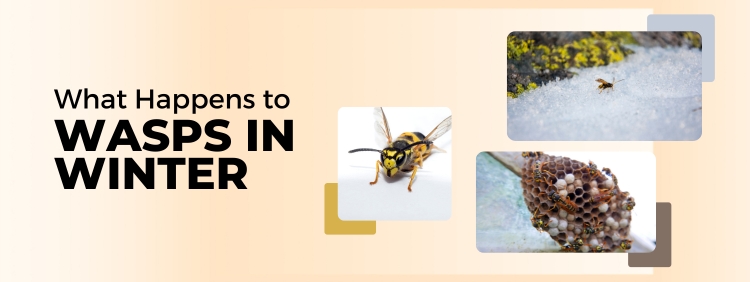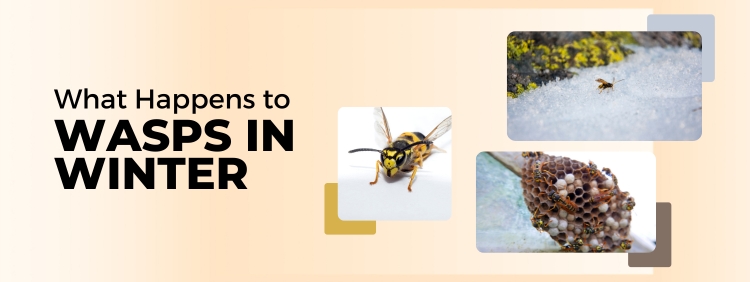
As frost blankets the scenery and winter’s chill takes hold, you might start wondering what happens to those buzzing, pesky wasps that were a fixture at summer barbecues. Well, get ready for a surprise! The wasp kingdom really comes alive during the cold season, revealing survival strategies, adaptations, and hierarchies.
It may not be a season to worry about wasp removal services in Toronto, but it is important to learn about these pests to protect your home when the warmer weather appears. Let’s dive into the captivating life cycle of wasps and explore what unfolds for them in the winter months.
Hibernation or Bust: Winter Survival Strategy of Wasps
Imagine this buzzing, stinging creature taking on the longest, coldest season of the year. Surprisingly, many wasp species handle winter admirably, with their unique behaviours and tough adaptations to conquer the cold.
But what exactly happens to wasps in winter? Do they simply snuggle up and hibernate, or do they have more intricate strategies to survive?
Let’s start with the simple question — what do we mean by hibernation? In simple terms, hibernation is a state of inactivity in which an animal conserves its energy by slowing down its metabolic processes. However, don’t let the simplicity of the term mislead you. The world of hibernation holds more fascinating secrets than one might expect.
-
Do Wasps Hibernate?
Essentially, the answer is yes, but not every type of wasp. Wasps are categorized into two types — solitary wasps and social wasps. Here’s the really fascinating part. Winter behaviour between these two types varies significantly.
Solitary wasps, as the name suggests, live alone. Their life spans are short (typically a few weeks), and their life cycle is completed within the warm season. The adult solitary wasps of summer do not survive to see the snow; instead, next year’s generations hibernate in the form of fertilized eggs or larvae.
On the other hand, social wasps are those that live in colonies, such as yellow jackets and hornets. Their strategy for confronting the winter is slightly different.
-
The Fate of the Wasp Colony
In the world of social wasps, all is not equal. A single queen starts the colony in the spring, and as summer advances, the colony grows with worker wasps. As winter approaches, though, the tree begins to lose its leaves — a metaphorical curtain call for the worker wasps. Remarkably, these loyal labourers do not survive the winter. Instead, they have already fulfilled their roles by ensuring the creation of new queens. It is these young queens, nurtured and protected by the winter-ready nest, that hold the future of wasps within them.
The Queen’s Quest for Survival in Winter
As winter approaches, the wasp queen embarks on a critical mission for survival. Unlike the rest of the colony, the queen doesn’t succumb to the chill of winter but instead goes into hibernation. This strategy, known as overwintering, involves finding a secure and insulated place to wait out the cold months.
During this time, her metabolism slows drastically, and she enters a state of physical inactivity, conserving energy until spring returns. Imagine it as nature’s way of equipping these creatures with an organic, energy-efficient sleep mode. Quite fascinating, isn’t it?
But what makes the queen wasp so unique, and how does she find her retreat?
The queen wasp, while built similarly to her worker counterparts, has subtle differences. Her larger size aids in surviving the winter, but more intriguing is her ability to store fat reserves. This stored energy helps sustain her during the hibernation period.
As for where she hibernates, the queen wasp demonstrates an impressive knack for finding cozy winter lodgings. She might choose a hole in tree bark, a quiet corner in a garden shed, or even inside your home if there’s a suitable, undisturbed nook.
Natural shelters: Holes in tree barks, under leaf piles, and in soil
Man-made shelters: Sheds, garages, attics, wall cavities, or other undisturbed parts of a home
When spring arrives, the queen wakes up from her hibernation and immediately gets to work establishing a new colony, thereby ensuring the continuation of her species.
Truly Nolen’s Four Season Pest Control Program
As we look into understanding the life of wasps, and particularly their winter survival strategies, it’s important to consider the role of diligent pest control services. Truly Nolen’s Four Season Pest Control Program has a strategy that is tailored for the distinct challenges posed by each season, including the winter months.
As most wasps retreat into their nests during chilly winters, their habitats remain vulnerable to intervention. The program’s winter measures focus on treating those hideouts, ensuring queen wasps don’t survive the cold months and preventing infestations.
Controlling wasp populations is important, as these insects can sting painfully when threatened. Acknowledging their presence is a necessary step to understanding our complex relationship with nature.
By learning about wasps and following careful pest control strategies, we can coexist safely and peacefully. Our winter program is just one step towards this goal, allowing us to protect our homes from unwanted visitors while maintaining a sustainable balance with the environment.
Tips for Preventing Unwanted Wasp Encounters
Although we’ve spent a lot of time exploring the wasps’ wintry world, it’s important for you to know how you can steer clear of any unwanted encounters. Wasps usually pose less of a problem during the cooler months. However, a disruptive human interaction might just ruffle their feathers – or rather, their wings! So, what measures can one take to prevent such situations?
- Home Inspection: Start with inspecting your home for traces of wasp activity. Their preferred habitats during winter are often insulated warm areas such as roof spaces and wall cavities. Check these areas carefully, and if you find a nest, do not try to remove it yourself – you could end up disturbing the colony.
- Sealing Points of Entry: Sealing points of entry in your house is key to wasp-proofing your home. Wasps can squeeze through the smallest of openings— gaps around windows and doors, vents, cracks and splits in the structure are all ideal access points for them. Therefore, maintaining a well-sealed house can lower the risk of a wasp visit.
- Clean Surroundings: Keeping your surroundings clean can significantly help reduce wasp attraction. This can be achieved by securing garbage lids, not leaving sweet food or pet food outdoors, and avoiding water collection as stagnated water can attract these insects.
So, although winter for wasps generally signifies a time of slowing down, it doesn’t exempt humans from their potential intrusion. By following these tips, you can create a safer space for you and your families while keeping the peace with our six-legged friends.
During our exploration, we searched deep into the survival strategies of wasps during the harsh winter months and the unique life cycles involving the queens and the worker wasps. We’ve even checked out how humans can safely coexist with these winged insects throughout the year. But you know what? Sometimes, no matter what you do, wasps might still show up where you least expect them.
That’s when Truly Nolen’s Four Season Pest Control Program comes to the rescue. With year-round protection, these expert guards ensure the safety of your home from pesky intruders. Whether you’re dealing with ants, bed bugs, rodents, or other pests, our dedicated team provides reliable pest control removal services in Toronto. Rest assured, we have the knowledge, experience, and advanced methods to keep your home pest-free and your family comfortable.
